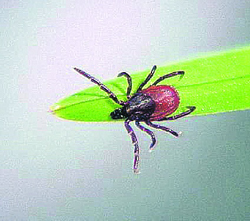| | Published June 19th, 2013
| Lyme Disease in Lamorinda? Not Likely
| | By Cathy Dausman |  | | In California, Ixodes pacificus is the only tick that transmits Lyme disease to people. Photo provided
|
Is Lyme disease, the most common vector-borne disease in the U.S. likely in Lamorinda? Not if you look at the numbers. Just five cases of Lyme disease were reported among the one million-plus residents of Contra Costa County between 2001 and 2011, although ticks in 42 counties in California were themselves infected. Only western black legged ticks carry Lyme disease, which causes fever, headache, fatigue, and a characteristic skin rash called erythema migrans. Left untreated, it can spread to joints, the heart, and the nervous system.
 "We haven't heard anything specific about Lyme disease, but we test for it quite often," said veterinarian Jamie Peyton, of Four Seasons Animal Hospital in Lafayette. "I don't know the numbers for this area, but I suspect the condition is under diagnosed in both animals and people in Northern California."
"We haven't heard anything specific about Lyme disease, but we test for it quite often," said veterinarian Jamie Peyton, of Four Seasons Animal Hospital in Lafayette. "I don't know the numbers for this area, but I suspect the condition is under diagnosed in both animals and people in Northern California."
 But take heart-in order to infect someone with Lyme disease, the western black legged tick must first be infected itself. Ticks acquire the bacteria Borreliaburgdorferi, the cause of Lyme disease, by feeding on infected mammals. Larval, nymph and adult ticks can pass Lyme disease on through their bite, but larva rarely bite and as little as 15 percent of nymphs and only 5 percent of adult ticks are infected. Dr. Abigail Kroch, Director of Epidemiology, Planning & Evaluation for Contra Costa County Health Services said: "We do not have enough reported cases to detect a trend."
But take heart-in order to infect someone with Lyme disease, the western black legged tick must first be infected itself. Ticks acquire the bacteria Borreliaburgdorferi, the cause of Lyme disease, by feeding on infected mammals. Larval, nymph and adult ticks can pass Lyme disease on through their bite, but larva rarely bite and as little as 15 percent of nymphs and only 5 percent of adult ticks are infected. Dr. Abigail Kroch, Director of Epidemiology, Planning & Evaluation for Contra Costa County Health Services said: "We do not have enough reported cases to detect a trend."
 Kroch also pointed out that although an infection is reported in Contra Costa County, the patient may have contracted the disease elsewhere. First discovered near Lyme, Conn., some 40 years ago, the disease made its way westward. California reported its first case of Lyme disease in 1978 when a Sonoma county hiker was infected. The state now averages 100 case reports per year, compared with approximately 2,000 cases reported nationwide.
Kroch also pointed out that although an infection is reported in Contra Costa County, the patient may have contracted the disease elsewhere. First discovered near Lyme, Conn., some 40 years ago, the disease made its way westward. California reported its first case of Lyme disease in 1978 when a Sonoma county hiker was infected. The state now averages 100 case reports per year, compared with approximately 2,000 cases reported nationwide.
 So, enjoy that summer hike, but take precautions. The California Department of Public Health suggests you stay on the trail. Wear light-colored clothes, a hat, long sleeved shirt and pants. Tuck in shirts and tuck pant legs into boots or socks. Treat clothing with permethrin insecticide, and apply DEET repellent to exposed skin. Thoroughly inspect for ticks and tick bites after being in tick habitat. If bitten, promptly and carefully remove the tick, and clean the area with soap and water.
So, enjoy that summer hike, but take precautions. The California Department of Public Health suggests you stay on the trail. Wear light-colored clothes, a hat, long sleeved shirt and pants. Tuck in shirts and tuck pant legs into boots or socks. Treat clothing with permethrin insecticide, and apply DEET repellent to exposed skin. Thoroughly inspect for ticks and tick bites after being in tick habitat. If bitten, promptly and carefully remove the tick, and clean the area with soap and water.
 Dead or live ticks can be tested for Borrelia at many local health departments. Preserve ticks moist in a small container. If you develop any symptoms up to one month after a bite, consult your physician, and explain that you were bitten by a tick.
Dead or live ticks can be tested for Borrelia at many local health departments. Preserve ticks moist in a small container. If you develop any symptoms up to one month after a bite, consult your physician, and explain that you were bitten by a tick.
 To find out more about Lyme disease in California, call (916) 552-9730 or visit the California Department of Public Health website: www.cdph.ca.gov/healthinfo/discond/Pages/LymeDisease.aspx. To find out more about Lyme disease in California, call (916) 552-9730 or visit the California Department of Public Health website: www.cdph.ca.gov/healthinfo/discond/Pages/LymeDisease.aspx.

|
| | | | | | | | | | | | | | |
| | | print story
Before you print this article, please remember that it will remain in our archive for you to visit anytime.
download pdf
(use the pdf document for best printing results!) | | | Comments | | |
| | | | | | | | | | | | | | | | |


